Choosing fabric for beach towels seems simple—but the wrong choice can lead to faded colors, scratchy texture, or towels that never dry quickly enough.
The best beach towel fabrics are 100% combed cotton, Turkish cotton, or microfiber. Each offers unique benefits in softness, absorbency, drying time, and durability. Match your choice to your market’s needs for a successful beach towel line.
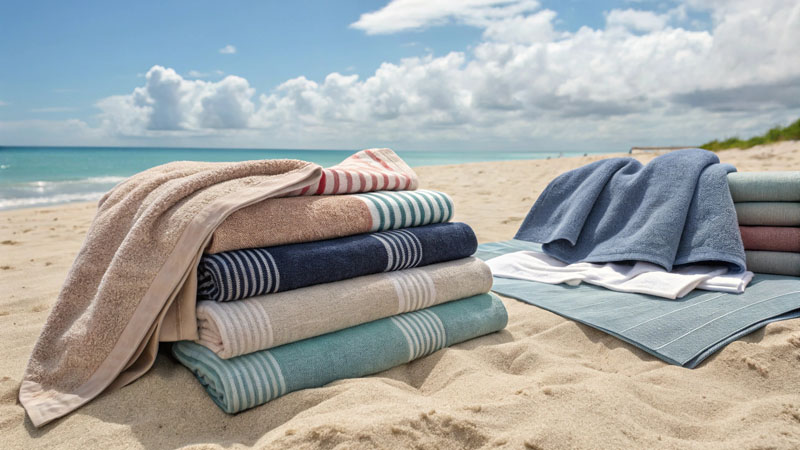
Customers judge a towel by the way it feels, holds up, and dries after each beach trip. With fabric at the heart of customer experience, getting it right is critical—let’s break down how to make the best choice for your brand, step by step.
What are the most popular fabrics for beach towels?
Fabric variety is bigger now than ever—making the wrong pick can disappoint your customers and harm your brand’s reputation.
The top choices for beach towel fabrics are cotton, Turkish cotton, Egpytian cotton, and microfiber. Each has different strengths for softness, absorbency, quick-drying, and weight.
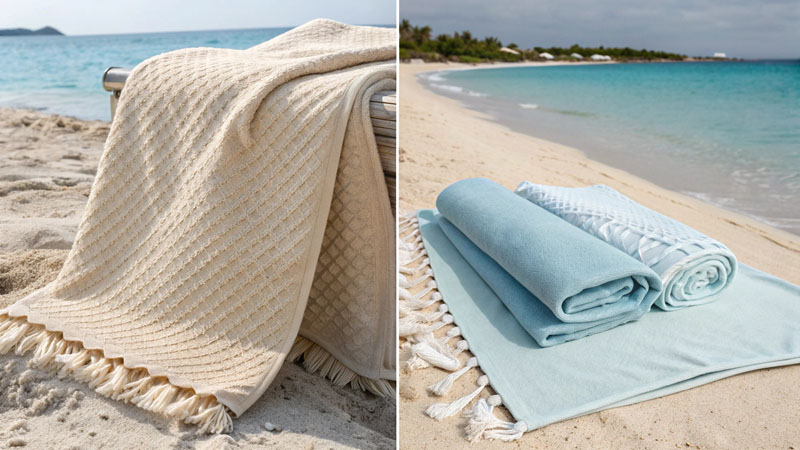
Popular Beach Towel Fabrics: Comparison Table
| Fabric | Feel | Absorbency | Dry Speed | Weight | Price Range |
|---|---|---|---|---|---|
| 100% Cotton | Soft/plush | High | Medium | Medium | $-$$ |
| Turkish Cotton | Very soft | High | Fast | Lightweight | $$ |
| Egyptian Cotton | Ultra-soft | Very High | Slow | Heavy | $$$ |
| Microfiber | Smooth/light | Medium | Fastest | Very light | $ |
Cotton and its variants offer superior softness and absorbency, while microfiber excels at compressibility and quick-drying—each serves a different type of user well.
How does fabric type affect towel performance at the beach?
Some towels soak up water but never dry out—others shed sand easily but get rough with use. Understanding how fabric impacts these traits is essential.
Combed cotton brings superior absorbency and plush feel but can feel heavy when wet. Turkish cotton features longer fibers, giving it a perfect balance of absorption and fast drying. Microfiber dries the quickest and repels sand but may appeal less to users who love classic terry softness.
To optimize your towels for the beach, choose Turkish cotton for balanced comfort and drying. For quick pack-and-go, microfiber suits active travelers. Standard cotton offers an affordable option for most buyers.
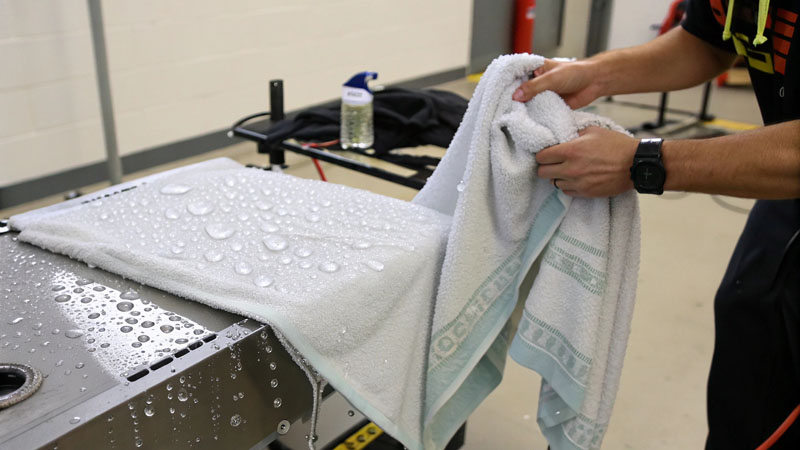
Fabric Performance Traits Table
| Fabric | Sand Resistance | Dry Speed | Dries Soft After Wet | Bulkiness When Wet |
|---|---|---|---|---|
| Combed Cotton | Moderate | Medium | Yes | Moderate |
| Turkish Cotton | Good | Fast | Yes | Less |
| Microfiber | Best | Fastest | Sometimes stiff | Minimal |
| Egyptian Cotton | Moderate | Slow | Very plush | High |
Choose Turkish cotton or microfiber for towels that won’t weigh your customer down after a swim.
Does fabric choice affect print quality and design options?
Your customer’s first impression often comes from eye-catching colors or patterns—some fabrics showcase vibrant prints better than others.
Cotton and Turkish cotton towels work best for bold, lasting prints using fiber-reactive dyes or jacquard weaving. Microfiber prints look sharp and detailed with sublimation, but thin fabrics can limit textured effects.
For rich colors and complex designs, opt for Turkish or combed cotton with fiber-reactive dye or woven jacquard techniques. Microfiber excels at photographic, edge-to-edge prints with modern, lightweight appeal.
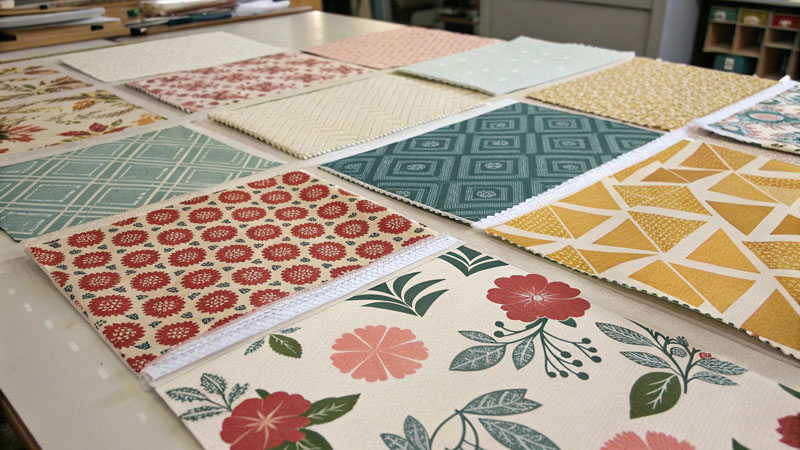
Print and Color Performance Table
| Fabric | Best Print Methods | Color Vibrancy | Texture Effects | Longevity |
|---|---|---|---|---|
| Turkish Cotton | Fiber-reactive print, Jacquard | High | Yes | Excellent |
| Combed Cotton | Fiber-reactive print | High | Yes | Excellent |
| Microfiber | Sublimation print | Very high/sharp | No (flat) | Good |
| Egyptian Cotton | Jacquard, Embroidery | High | Yes | Excellent |
Pair the right fabric with the correct print process to uncomplicate design decisions and deliver towels your clients will love season after season.
How does fabric impact durability, maintenance, and feel over time?
First-time buyers want soft, vibrant towels, but a towel’s true quality stands up to sand, salt, sun, and frequent washes.
Turkish and combed cotton maintain softness and structure after many washes, especially if properly hemmed. Microfiber resists stains and dries quickly, but can snag or become stiff if not laundered with care. Egyptian cotton offers long-term luxury but can show wear and color fading if overexposed.
For the best combination of longevity and feel, Turkish cotton wins—its long fibers and high-quality spinning maintain comfort, color, and durability even in harsh beach environments.
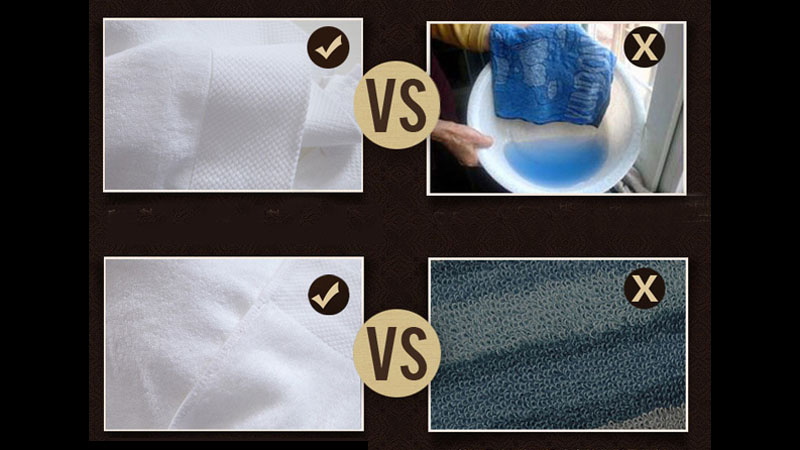
Durability and Maintenance Table
| Fabric | Withstands Frequent Washing | Holding Color | Prone to Snags | Long-Term Softness |
|---|---|---|---|---|
| Turkish Cotton | Yes | Excellent | Low | Yes |
| Combed Cotton | Yes | Good | Moderate | Yes |
| Microfiber | Good (if washed properly) | Excellent | Yes | Moderate |
| Egyptian Cotton | Yes | Moderate | Low | Yes |
With the right construction and care instructions, high-quality cotton towels outlast most alternatives and maintain customer satisfaction longer.
What’s the role of fabric certification and sustainability?
Today’s buyers care about safe, ethical, and eco-friendly textiles—your choice of fabric and certifications can make or break a brand’s credibility.
Look for OEKO-TEX, GOTS (organic), or BCI Cotton certifications to show safety and sustainability. Turkish and combed cotton are readily available with these assurances, while recycled microfiber and eco cotton blends offer greener options for eco-focused brands.
Certifications like OEKO-TEX and GOTS build trust and support premium pricing. If sustainability is a key value, select certified Turkish or organic cotton for beach towels.

Sustainability Certifications Table
| Certification | Applies To | What It Means |
|---|---|---|
| OEKO-TEX | All fabrics | Free from harmful chemicals |
| GOTS | Organic cotton | Organic, safe, traceable |
| BCI Cotton | Cotton fabrics | Sustainable, improved farming |
| Recycled Microfiber | Synthetics | Uses post-consumer recycled plastics |
Order certified samples and show documentation on labeling and branding—this reassures retailers and final customers.
Conclusion
Choosing the right fabric sets the foundation for every successful beach towel collection. In 15 years, I’ve seen Turkish cotton deliver the very best combination of comfort, color, and commercial durability. Always think beyond softness: test drying speed, sand resistance, print quality, and certification status before launching your next line. Great fabric choices make for loyal customers and a strong, reliable brand.
Professional Insights from Airswimwear’s 15 Years of Expertise
- Invest first in Turkish cotton for the best ratio of feel, drying speed, and longevity—customers notice the difference, even after one use.
- Request wash-tested and sand-tested samples from suppliers, especially for new weaves or microfiber, to catch performance issues before launch.
- For print-driven brands, always pair fiber-reactive dyeing or advanced sublimation with appropriate, pre-treated fabrics for rich, fade-resistant colors.
- Adding clear care labels and highlighting certifications (OEKO-TEX, GOTS) in your marketing increases consumer trust and signals attention to quality and sustainability.
FAQs
What fabric offers the quickest drying time for beach towels?
Microfiber dries the fastest. Turkish cotton is the next best for rapid air-drying and comfort.
How can I check if my towel fabric is truly sustainable?
Look for trusted labels like OEKO-TEX, GOTS, or BCI, and always request certificates from your supplier.
What fabric is best for sand resistance?
Microfiber is the most sand-resistant, while Turkish cotton in a flat weave (like Turkish peshtemal) also performs very well.
Do all types of cotton towels feel the same after washing?
No—long-staple and combed cotton towels (like Turkish and Egyptian) feel softer for longer, especially with proper care.
Can I get custom prints on microfiber and cotton beach towels?
Yes, with the right print process—fiber-reactive for cotton; sublimation for microfiber. Always test for colorfastness.
Is it possible to make eco-friendly towels with vibrant, trendy colors?
Yes—modern dye technology allows certified organic or BCI cottons to showcase bold, on-trend shades with proper preparation and dyeing techniques.
.png)







-1024x337.png)